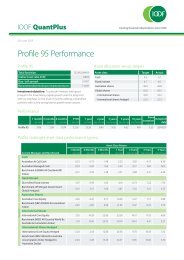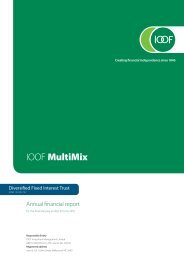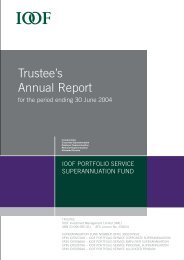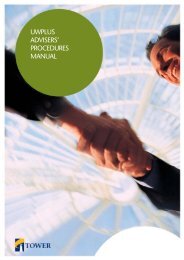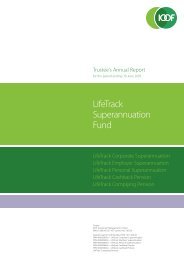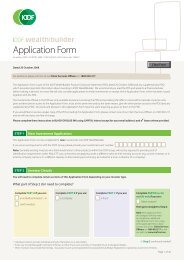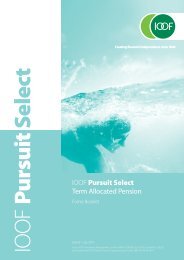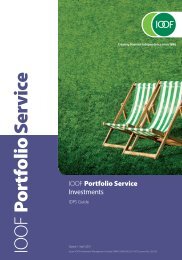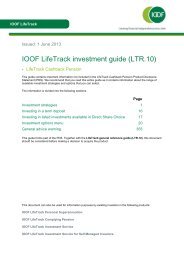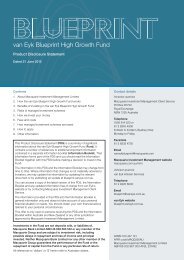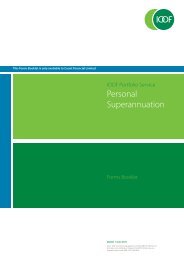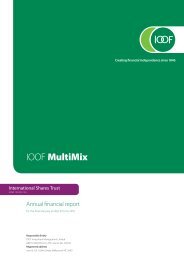annual report 2011
annual report 2011
annual report 2011
Create successful ePaper yourself
Turn your PDF publications into a flip-book with our unique Google optimized e-Paper software.
IOOF | <strong>annual</strong> <strong>report</strong> <strong>2011</strong><br />
items comprise mainly corporate assets, head office expenses,<br />
and income tax assets and liabilities.<br />
Segment capital expenditure is the total cost incurred during<br />
the period to acquire property and equipment, and intangible<br />
assets other than goodwill.<br />
(w) Liability to buy back vested shares<br />
A liability has been recognised in respect of an obligation by<br />
the Group to buy back vested shares in some Perennial Group<br />
subsidiaries under certain circumstances. The above liabilities<br />
are recorded at fair value. Determination of fair value has<br />
required assumptions concerning future growth, discount rates<br />
and fund flows.<br />
For further information on valuation methods for the liability to<br />
buy back vested shares refer to note 5(e) fair value estimation.<br />
Change in accounting policy<br />
Under the previous accounting policy, changes in the fair value<br />
of the buy back liability were recognised in profit or loss. The<br />
change in accounting policy is to recognise these movements<br />
in a share buy back revaluation reserve which more accurately<br />
reflects the nature of the underlying instrument. The liability<br />
to buy back vested shares is measured and recognised in<br />
accordance with AASB 139 Financial Instruments: Recognition<br />
and Measurement precluding any adjustment for the<br />
probability that settlement of the liability will occur. The<br />
directors have assessed the probability that the Group will<br />
be required to settle the share buy back liability as low and<br />
therefore recognition of movements in the reserve provides<br />
users with increased relevance and reliability of the financial<br />
performance of the Group.<br />
(x) New standards and interpretations not yet<br />
adopted<br />
A number of new standards, amendments to standards and<br />
interpretations are effective for <strong>annual</strong> periods beginning<br />
after 1 July <strong>2011</strong>, and have not been applied in preparing<br />
these consolidated financial statements. None of these is<br />
expected to have a significant effect on the consolidated<br />
financial statements of the Group, except for AASB 9 Financial<br />
Instruments, which becomes mandatory for the Group’s 2014<br />
consolidated financial statements and could change the<br />
classification and measurement of financial assets. The Group<br />
does not plan to adopt this standard early and the extent of<br />
the impact has not been determined. In addition, there are<br />
new standards due to be effective for periods beginning after<br />
I July 2013, AASB 10 Consolidated Financial Statements, AASB 11<br />
Joint Arrangements, AASB 12 Disclosure of interest in other entities<br />
and AASB 13 Fair value measurement. The extent of the impact<br />
has not yet been determined.<br />
(y) Parent entity financial statements<br />
Parent entity information has been reinstated in accordance<br />
with a directive from the Australian Prudential Regulatory<br />
Authority dated 1 September 2010 to all its regulated entities.<br />
Disclosure of parent entity information is not required under<br />
the Corporations Act 2001.<br />
This change in accounting policy has had an effect on<br />
consolidated earnings per share and on net profit, further<br />
information is provided in note 4 Change in accounting<br />
policy. A third balance sheet has also been presented on the<br />
statement of financial position.<br />
page 65



